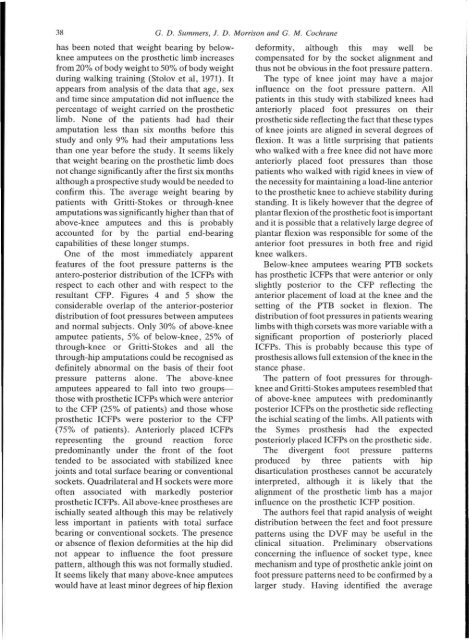View Complete Issue PDF
View Complete Issue PDF
View Complete Issue PDF
Create successful ePaper yourself
Turn your PDF publications into a flip-book with our unique Google optimized e-Paper software.
has been noted that weight bearing by belowknee<br />
amputees on the prosthetic limb increases<br />
from 20% of body weight to 50% of body weight<br />
during walking training (Stolov et al, 1971). It<br />
appears from analysis of the data that age, sex<br />
and time since amputation did not influence the<br />
percentage of weight carried on the prosthetic<br />
limb. None of the patients had had their<br />
amputation less than six months before this<br />
study and only 9% had their amputations less<br />
than one year before the study. It seems likely<br />
that weight bearing on the prosthetic limb does<br />
not change significantly after the first six months<br />
although a prospective study would be needed to<br />
confirm this. The average weight bearing by<br />
patients with Gritti-Stokes or through-knee<br />
amputations was significantly higher than that of<br />
above-knee amputees and this is probably<br />
accounted for by the partial end-bearing<br />
capabilities of these longer stumps.<br />
One of the most immediately apparent<br />
features of the foot pressure patterns is the<br />
antero-posterior distribution of the ICFPs with<br />
respect to each other and with respect to the<br />
resultant CFP. Figures 4 and 5 show the<br />
considerable overlap of the anterior-posterior<br />
distribution of foot pressures between amputees<br />
and normal subjects. Only 30% of above-knee<br />
amputee patients, 5% of below-knee, 25% of<br />
through-knee or Gritti-Stokes and all the<br />
through-hip amputations could be recognised as<br />
definitely abnormal on the basis of their foot<br />
pressure patterns alone. The above-knee<br />
amputees appeared to fall into two groups—<br />
those with prosthetic ICFPs which were anterior<br />
to the CFP (25% of patients) and those whose<br />
prosthetic ICFPs were posterior to the CFP<br />
(75% of patients). Anteriorly placed ICFPs<br />
representing the ground reaction force<br />
predominantly under the front of the foot<br />
tended to be associated with stabilized knee<br />
joints and total surface bearing or conventional<br />
sockets. Quadrilateral and H sockets were more<br />
often associated with markedly posterior<br />
prosthetic ICFPs. All above-knee prostheses are<br />
ischially seated although this may be relatively<br />
less important in patients with total surface<br />
bearing or conventional sockets. The presence<br />
or absence of flexion deformities at the hip did<br />
not appear to influence the foot pressure<br />
pattern, although this was not formally studied.<br />
It seems likely that many above-knee amputees<br />
would have at least minor degrees of hip flexion<br />
deformity, although this may well be<br />
compensated for by the socket alignment and<br />
thus not be obvious in the foot pressure pattern.<br />
The type of knee joint may have a major<br />
influence on the foot pressure pattern. All<br />
patients in this study with stabilized knees had<br />
anteriorly placed foot pressures on their<br />
prosthetic side reflecting the fact that these types<br />
of knee joints are aligned in several degrees of<br />
flexion. It was a little surprising that patients<br />
who walked with a free knee did not have more<br />
anteriorly placed foot pressures than those<br />
patients who walked with rigid knees in view of<br />
the necessity for maintaining a load-line anterior<br />
to the prosthetic knee to achieve stability during<br />
standing. It is likely however that the degree of<br />
plantar flexion of the prosthetic foot is important<br />
and it is possible that a relatively large degree of<br />
plantar flexion was responsible for some of the<br />
anterior foot pressures in both free and rigid<br />
knee walkers.<br />
Below-knee amputees wearing PTB sockets<br />
has prosthetic ICFPs that were anterior or only<br />
slightly posterior to the CFP reflecting the<br />
anterior placement of load at the knee and the<br />
setting of the PTB socket in flexion. The<br />
distribution of foot pressures in patients wearing<br />
limbs with thigh corsets was more variable with a<br />
significant proportion of posteriorly placed<br />
ICFPs. This is probably because this type of<br />
prosthesis allows full extension of the knee in the<br />
stance phase.<br />
The pattern of foot pressures for throughknee<br />
and Gritti-Stokes amputees resembled that<br />
of above-knee amputees with predominantly<br />
posterior ICFPs on the prosthetic side reflecting<br />
the ischial seating of the limbs. All patients with<br />
the Symes prosthesis had the expected<br />
posteriorly placed ICFPs on the prosthetic side.<br />
The divergent foot pressure patterns<br />
produced by three patients with hip<br />
disarticulation prostheses cannot be accurately<br />
interpreted, although it is likely that the<br />
alignment of the prosthetic limb has a major<br />
influence on the prosthetic ICFP position.<br />
The authors feel that rapid analysis of weight<br />
distribution between the feet and foot pressure<br />
patterns using the DVF may be useful in the<br />
clinical situation. Preliminary observations<br />
concerning the influence of socket type, knee<br />
mechanism and type of prosthetic ankle joint on<br />
foot pressure patterns need to be confirmed by a<br />
larger study. Having identified the average
















